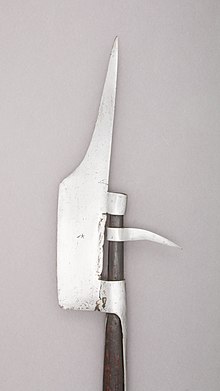
A polearm or pole weapon is a close combat weapon in which the main fighting part of the weapon is fitted to the end of a long shaft, typically of wood, extending the user's effective range and striking power. Polearms are predominantly melee weapons, with a subclass of spear-like designs fit for thrusting and/or throwing. Because many polearms were adapted from agricultural implements or other fairly abundant tools, and contained relatively little metal, they were cheap to make and readily available. When belligerents in warfare had a poorer class who could not pay for dedicated military weapons, they would often appropriate tools as cheap weapons. The cost of training was comparatively low, since these conscripted farmers had spent most of their lives using these "weapons" in the fields. This made polearms the favoured weapon of peasant levies and peasant rebellions the world over.
A spear is a polearm consisting of a shaft, usually of wood, with a pointed head. The head may be simply the sharpened end of the shaft itself, as is the case with fire hardened spears, or it may be made of a more durable material fastened to the shaft, such as bone, flint, obsidian, copper, bronze, iron, or steel. The most common design for hunting and/or warfare, since ancient times has incorporated a metal spearhead shaped like a triangle, diamond, or leaf. The heads of fishing spears usually feature multiple sharp points, with or without barbs.

A pike is a long thrusting spear formerly used in European warfare from the Late Middle Ages and most of the early modern period, and wielded by foot soldiers deployed in pike square formation, until it was largely replaced by bayonet-equipped muskets. The pike was particularly well known as the primary weapon of Swiss mercenary, German Landsknecht units and French sans-culottes. A similar weapon, the sarissa, had been used in antiquity by Alexander the Great's Macedonian phalanx infantry.

A bill is a class of agricultural implement used for trimming tree limbs, which was often repurposed for use as an infantry polearm. In English, the term 'Italian bill' is applied to the similar roncone or roncola, but the Italian version tended to have a long thrusting spike in addition to the cutting blade.

A glaive, sometimes spelled as glave, is a type of pole weapon with historical origins in Europe, known for its distinctive design and versatile combat applications. It is similar to other polearms such as the war scythe, the Japanese naginata, the Chinese guandao, the Korean woldo, and the Russian sovnya.

A bardiche, berdiche, bardische, bardeche, or berdish is a type of polearm used from the 14th to 17th centuries in Europe. Ultimately a descendant of the medieval sparth axe or Dane axe, the bardiche proper appears around 1400, but there are numerous medieval manuscripts that depict very similar weapons beginning c. 1250. The bardiche differs from the halberd in having neither a hook at the back nor a spear point at the top. The use of bardiches started in early 14th-century Austria.

The Lochaber axe is a type of poleaxe that was used almost exclusively in Scotland. It was usually mounted on a staff about five feet long.

The Dane axe or long axe is a type of European early medieval period two-handed battle axe with a very long shaft, around 0.9–1.2 metres at the low end to 1.5–1.7 metres or more at the long end. Sometimes called a broadaxe, the blade was broad and thin, intended to give a long powerful cut when swung, effective against cavalry, shields and unarmored opponents.
A spontoon, sometimes known by the variant spelling espontoon or as a half-pike, is a type of European polearm that came into being alongside the pike. The spontoon was in common use from the mid-17th century to the early 19th century, but it was used to a much lesser extent as a military weapon and ceremonial implement until the late 19th century.

The poleaxe is a European polearm that was used by medieval infantry.
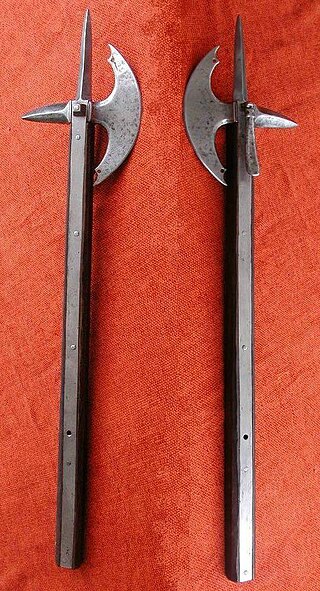
A battle axe is an axe specifically designed for combat. Battle axes were specialized versions of utility axes. Many were suitable for use in one hand, while others were larger and were deployed two-handed.

The dagger-axe is a type of polearm that was in use from the Longshan culture until the Han dynasty in China. It consists of a dagger-shaped blade, mounted by its tang to a perpendicular wooden shaft. The earliest dagger-axe blades were made of stone. Later versions used bronze. Jade versions were also made for ceremonial use. There is a variant type with a divided two-part head, consisting of the usual straight blade and a scythe-like blade.
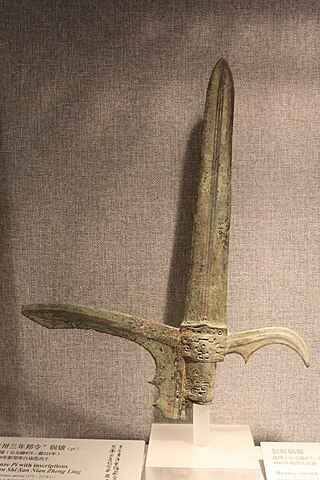
The ji was a Chinese polearm, sometimes translated into English as spear or halberd, though they are fundamentally different weapons. They were used in one form or another for over 3000 years, from at least as early as the Zhou dynasty, until the end of the Qing dynasty. They are still used for training purposes in many Chinese martial arts.
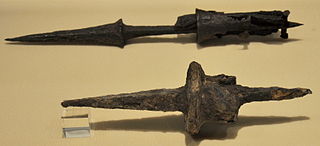
A goedendag was a weapon originally used by the militias of Medieval Flanders in the 14th century, notably during the Franco-Flemish War. The goedendag was essentially a combination of a club with a spear. Its body was a wooden staff roughly 90 cm to 150 cm long with a diameter of roughly 5 cm to 10 cm. It was wider at one end, and at this end a sharp metal spike was inserted by a tang.

Pike and shot was a historical infantry tactical formation that first appeared during the late 15th and early 16th centuries, and was used until the development of the bayonet in the late 17th century. This type of formation combined soldiers armed with pikes and soldiers armed with arquebuses and/or muskets. Other weapons such as swords, halberds, and crossbows were also sometimes used. The formation was initially developed by the Holy Roman Imperial (Landsknechte) and Spanish (Tercios) infantries, and later by the Dutch and Swedish armies in the 17th century.
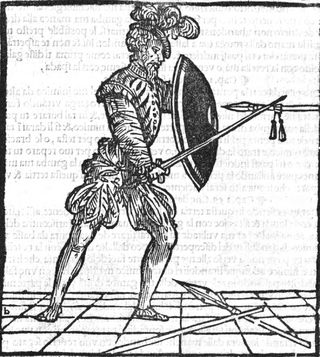
Rodeleros, also called espadachines ("swordsmen") and colloquially known as "Sword and Buckler Men", were Spanish troops in the early 16th century, equipped with steel shields known as rodela and swords . Originally conceived as an Italian attempt to revive the legionary swordsman, they were adopted by the Spanish and used with great efficiency in the Italian Wars during the 1510s and 1520s, but discontinued in the 1530s.
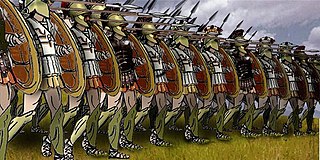
Heavy infantry consisted of heavily armed and armoured infantrymen who were trained to mount frontal assaults and/or anchor the defensive center of a battle line. This differentiated them from light infantry who are relatively mobile and lightly armoured skirmisher troops intended for screening, scouting, and other tactical roles unsuited to soldiers carrying heavier loads. Heavy infantry typically made use of dense battlefield formations, such as shield wall or phalanx, multiplying their effective weight of arms with force concentration.

The Swiss developed a number of characteristic weapons during their period of military activity in the 15th and early 16th centuries, perfected further during the Early Modern period.

Many of the polearms used in Scotland up to the beginning of the 16th century were similar to those used in other parts of the world; however, a number of distinct forms did evolve. The nomenclature of Scottish axes, in particular, is confusing, and the text below follows the classification scheme proposed by David H. Caldwell in his 1980 paper "Some Notes on Scottish Axes and Long Shafted Weapons".

The three most common types of Chinese polearms are the ge (戈), qiang (槍), and ji (戟). They are translated into English as dagger-axe, spear, and halberd. Dagger-axes were originally a short slashing weapon with a 0.9–1.8 m long shaft, but around the 4th century BC a spearhead was added to the blade, and it became a halberd. The spear is also sometimes called a mao (矛), which is sometimes used to designate polearms with a wavy snake-like spearhead. There was another polearm weapon known as the pi (鈹), translated into English as either sword-staff or long lance, that was used from ancient times until the Han dynasty. It was essentially a short sword attached to a stick. From the Warring States period onward, the length of Chinese polearms varied from around 2.8 to 5.5 m ; however, there is no specific designation for a pike in the traditional Chinese lexicon. A very long spear is just called a long spear.




